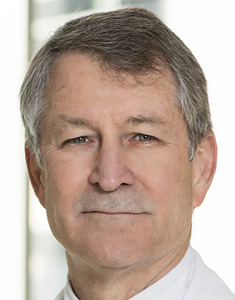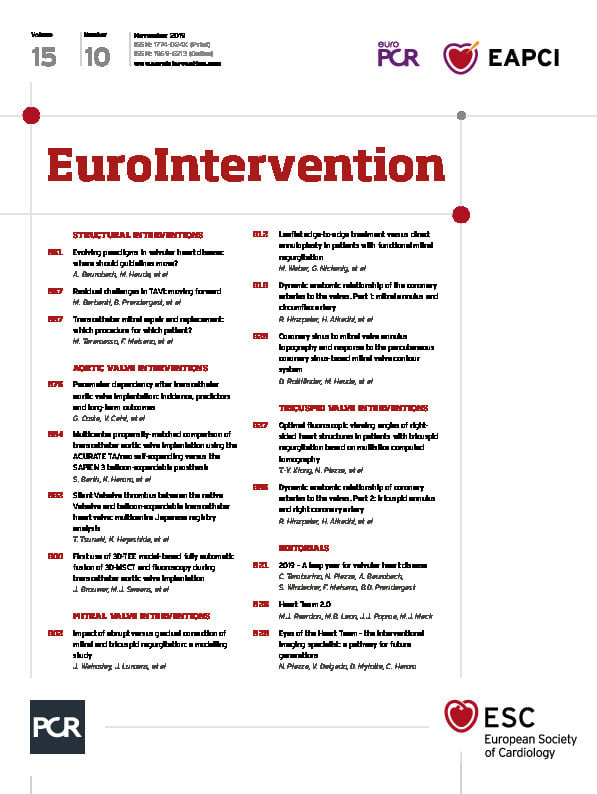
The management of all diseases can range from the simple to the very complex. This holds true for cardiovascular diseases with a tendency to favour the complex end of the spectrum. The concept of treating complex disease with the input of a multidisciplinary team is not new. The care and management of malignant diseases and organ transplantation has long used such multidisciplinary teams to achieve appropriate diagnosis, treatment planning and execution. In the cardiovascular world this was highlighted by the use of Heart Teams in the SYNTAX trial and the benefit seen from this approach1. In both the oncology and coronary revascularisation approaches, the team helped to define the best medical option for treatment but the treatment chosen could generally only be performed by one member of the group. There was little or no crossover between either chemotherapy versus oncologic surgery or percutaneous coronary intervention versus coronary artery bypass, making for a harmonious team.
Since the first successful case in 2002, transcatheter aortic valve replacement (TAVR) has exploded into the cardiovascular world, changing the basic management options for aortic valve stenosis. With the recent presentation and publication of two low-risk randomised trials showing positive results for TAVR compared with surgical aortic valve replacement (SAVR), surgical risk as a standalone factor has effectively been removed from the decision considerations2,3. All members of the Heart Team, including the patient, should have a say and participate in the shared decision on choosing the appropriate treatment for each individual patient. Unlike oncology and coronary care, if TAVR is chosen, two distinct members of the Heart Team, the interventional cardiologist (IC) and the cardiac surgeon (CS), can technically perform the procedure and, ideally, do this together to get the best of both worlds. However, not everyone agrees with this approach; the need for a Heart Team has been questioned by some. Despite dis-agreement from some individuals, the professional societies of both Europe and the USA include the use of the Heart Team as a class I indication in structural heart disease and the Center for Medicare and Medicaid Services (CMS) in the USA has mandated joint procedure participation4,5. This year, for the first time, London Valves will be incorporating the Mitral Valve Meeting of Zurich, adding emphasis at the Course to the mitral and tricuspid valves. With this expansion we believe it is appropriate to consider the future of the Heart Team, its need in our expanding treatment option world and how best to organise and run such a team.
In the TAVR world we have seen a rapid expansion of the procedure, with device and procedural iterations that have made it an extremely safe and relatively simple procedure to perform. With this level of procedural ease and safety do we still need the Heart Team? The initial TAVR randomised trials concerned TAVR versus high-risk SAVR and surgeons served as the arbitrators of the risk level6,7. With the publication of the two low-risk randomised trials, the removal by the FDA of risk level as a requirement for TAVR in the two tested valves, and the virtual elimination of any transthoracic access needs in TAVR, some have argued that the role of the surgeon is obsolete. Surgical risk may now have become moot as an individual component but are all low-risk patients appropriate for TAVR? The answer to this is clearly no and how we decide between TAVR and SAVR remains something best accomplished by the multidisciplinary team with patient input.
The first issue for surgeons considering SAVR is often age and whether the patient should receive a mechanical or a tissue valve. This decision is based on the surgeon’s understanding of the durability of the tissue valves available, the patient’s potential survival time, the risks of anticoagulation and the patient’s desires. The durability of surgical tissue valves is directly related to the patient’s age when implanted. Tissue valves have generally been used in older patients when the potential for patient survival time and valve durability begin to approach one another; however, where this break point occurs has been argued for decades by cardiac surgeons. The first decision branch point for TAVR should be, is a tissue valve appropriate for this patient? Since, over many decades, surgeons have not settled on an age to begin the use of tissue valves, it is unlikely that we will have a quick answer as to what age is appropriate for a TAVR valve. It is here that a well-informed Heart Team can help with understanding the data available and which populations were actually tested in the low-risk randomised trials. In the Evolut Low Risk trial there was no lower age limit on patients who could be accepted into the trial, but only 90 patients were less than 65 years old, and only 20 (1.3%) of these were less than 60 years old out of the 1,468 patients tested3. In the PARTNER 3 Low Risk trial only 7% of the patients randomised were less than 65 years old. In addition, the patients in both trials were screened by their local Heart Teams and had to be deemed suitable for both TAVR and SAVR prior to evaluation by national screening committees. Despite this local prescreening for acceptability, 520/1,520 (34%) in the balloon-expandable (BE) trial and 255/1,723 (14.8%) in the self-expanding valve (SEV) trial were deemed inappropriate for TAVR at the national level and failed the screening process. Careful screening by experienced Heart Team members and national screening committees clearly showed that not all cases are currently believed best for TAVR. TAVR will continue to grow and many low-risk patients will be deemed suitable for this treatment; however, the decision-making process remains important. Decisions will benefit from a well-functioning, multidisciplinary Heart Team and will help us to maintain the excellent results in the clinical trials that have propelled TAVR to this point.
The addition this year of the Zurich meeting, with emphasis on the mitral and tricuspid space, brings us to a significantly more complex arena. Both the decision-making process and the procedural options available are more complex and challenging than aortic stenosis treatment. The only mitral catheter intervention currently to have gained widespread use is the MitraClip™ procedure (Abbott Vascular, Santa Clara, CA, USA); its growth has been far below that of TAVR with ~7,200 MitraClip procedures versus ~62,000 TAVR procedures performed in the USA in 2018. Cardiac surgeons have long recognised that mitral valve regurgitation is fundamentally different in its primary and secondary aetiologies, with both treatment options and outcomes being markedly different. In the mitral space for the common lesion of regurgitation, repair in primary MR can restore a patient to both quality and normal length of life – something that valve replacement, as in aortic stenosis (AS), cannot do. The anatomy for the mitral and tricuspid valves is also significantly more complex than the aortic valve. Cardiac surgeons have spent their careers looking directly at and manipulating these valves, imagers look indirectly at these valves to define their pathology and interventionalists develop the advanced catheter skills that will be needed for these interventions. In the secondary form of mitral and tricuspid valve disease the underlying problem is heart failure. The importance of appropriate guideline-directed heart failure treatment (and how often it was not being achieved without heart failure specialist input) was highlighted by the positive results in the COAPT trial. Making the decision on treatment options in the mitral and tricuspid space and optimally executing these options requires input from expert imagers, heart failure specialists, cardiologist, surgeons and the patient.
As the treatment options and procedural requirements grow increasingly complex, advancing to the Heart Team 2.0 will be essential for programmes that want to lead with optimal success. The Heart Team 2.0 is now far more than an IC and a CS discussing treatment options. Dedicated and expert imagers and heart failure physicians (particularly in the mitral/tricuspid space) are essential. Even in TAVR, as we move to younger and lower-risk patients, a multidisciplinary team will help the patient to understand best the pros and cons of the available treatment options and the risks of each. Beyond the physicians, many structural heart programmes now have extremely busy clinics and patient treatment needs which require an increased role for midlevel care providers. The ability to organise and streamline this for the benefit of the patients requires dedicated and knowledgeable coordinators, social workers and nurses.
Far from being obsolete, the Heart Team is now needed more than ever. Moving to the Heart Team 2.0 will be in the best interests of our patients as well as our field of structural heart care.
Conflict of interest statement
M.J. Reardon is a consultant to Medtronic, Boston Scientific and Gore Medical. M.B. Leon has received research grants from BSC, Edwards Lifesciences, Medtronic and is an unpaid member on the scientific advisory boards of BSC, Edwards Lifesciences, Gore and Medtronic. J. Popma is on the Medical Advisory Board of Boston Scientific and has received institutional grants from Boston Scientific, Medtronic, Abbott and Edwards. M. Mack has received non-financial support from Edwards Lifesciences, Abbott and Medtronic.

